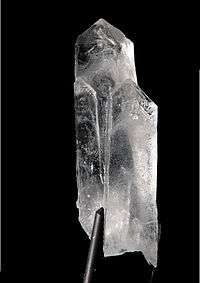Ammonium dihydrogen phosphate
 | |||
 | |||
| |||
| Names | |||
|---|---|---|---|
| IUPAC name
ammonium dihydrogen phosphate | |||
| Other names
monoammonium phosphate | |||
| Identifiers | |||
| 7722-76-1 | |||
| 3D model (Jmol) | Interactive image | ||
| ChemSpider | 22812 | ||
| ECHA InfoCard | 100.028.877 | ||
| EC Number | 231-764-5 | ||
| PubChem | 24402 | ||
| |||
| |||
| Properties | |||
| H6NO4P | |||
| Molar mass | 115.02 g·mol−1 | ||
| Appearance | white crystals | ||
| Odor | faint acid | ||
| Density | 1.80 g/cm3 | ||
| Melting point | 190 °C (374 °F; 463 K) | ||
| 40.4 g/100 mL | |||
| Solubility | soluble in ethanol insoluble in acetone | ||
| Refractive index (nD) |
1.525 | ||
| Structure | |||
| tetragonal | |||
| Thermochemistry | |||
| Std enthalpy of formation (ΔfH |
−1445.07 kJ/mol | ||
| Hazards | |||
| NFPA 704 | |||
| Lethal dose or concentration (LD, LC): | |||
| LD50 (median dose) |
5750 mg/kg (rat, oral) | ||
| Related compounds | |||
| Other anions |
Ammonium phosphate Diammonium phosphate | ||
| Other cations |
Monosodium phosphate Potassium dihydrogen phosphate | ||
| Except where otherwise noted, data are given for materials in their standard state (at 25 °C [77 °F], 100 kPa). | |||
| | |||
| Infobox references | |||
Ammonium dihydrogen phosphate (ADP), also known as monoammonium phosphate (MAP),[2] NH4H2PO4, is formed when a solution of phosphoric acid is added to ammonia until the solution is distinctly acidic. It crystallizes in tetragonal prisms. Monoammonium phosphate is often used in the blending of dry agricultural fertilizers.[3] It supplies soil with the elements nitrogen and phosphorus in a form usable by plants. The compound is also a component of the ABC powder in some dry chemical fire extinguishers. This substance is also supplied in an emerald green, amethyst, or aquamarine crystal growing box kit for children.
Solid monoammonium phosphate shows a dissociation pressure of ammonia of 0.05 mm Hg at 125 °C based on the decomposition reaction as follows:[4]
- NH4H2PO4(s) ⇌ NH3(g) + H3PO4(l)
ADP is a widely used crystal in the field of optics due to its birefringence properties. As a result of its tetragonal crystal structure, this material has negative uniaxial optical symmetry with typical refractive indices no = 1.522 and ne = 1.478 at optical wavelengths.[5]
ADP crystals are piezoelectric, a property required in some active sonar transducers (the alternative being transducers that use magnetostriction). In the 1950s ADP crystals largely replaced the quartz and Rochelle salt crystals in transducers because they are easier to work than Quartz and, unlike Rochelle Salt, are not deliquescent.[6]
Uses
MAP is mainly used as a fertilizer, but also as dry fire extinguisher. However MAP is also used in children's crystal growing experiment uses.
References
- ↑ Lide, David R. (1998). Handbook of Chemistry and Physics (87 ed.). Boca Raton, FL: CRC Press. pp. 4–40. ISBN 0-8493-0594-2.
- ↑ "Monoammonium Phosphate (MAP)" (PDF). www.mosaicco.com. Retrieved 2015-06-05.
- ↑ IPNI. "Monoammonium Phosphate (MAP)" (PDF). www.ipni.net. International Plant Nutrition Institute. Retrieved 21 July 2014.
- ↑ John R Van Wazer (1958). Phosphorus And Its Compounds - Volume I: Chemistry. New York: Interscience Publishers, Inc. p. 503.
- ↑ Amnon Yariv, Pochi Yeh (1984). Optical Waves in Crystals. Wiley, Inc.
- ↑ Willem Hackmann (1984). Seek and Strike: Sonar, Anti-Submarine Warfare and the Royal Navy, 1914–1954. Her Majesty's Stationery Office. ISBN 0-11-290423-8.



